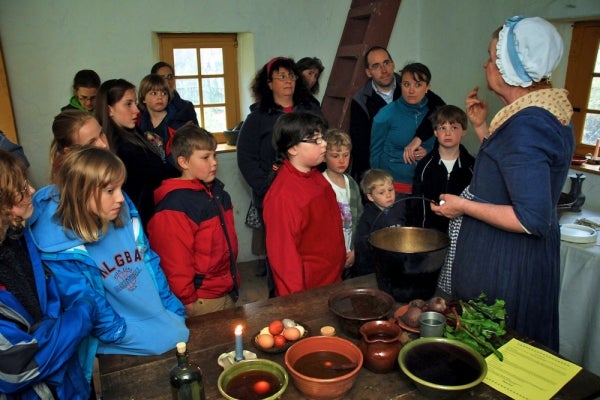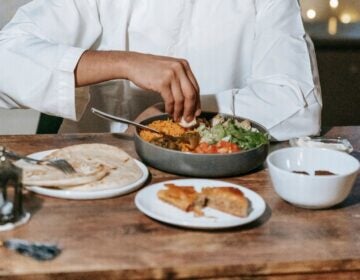An organic spin on an Easter tradition
About 20 local children and their parents crammed into Rittenhouse Town’s 18th century bake house off Lincoln Drive last weekend to take part in an Easter tradition with an untraditional twist.
Using only onion skins, turmeric, paprika and vinegar, Deborah Peterson, a “historic cook” from Plymouthville, turned hard-boiled eggs into pieces of culinary art, all while demonstrating to the ten young onlookers the ways in which organic materials can sometimes replace store-bought items for crafts.
“My daughter likes projects, and when I told her it was all about making your own dyes rather than going to the supermarket and buying tablets, I think she was interested,” said Pam Loughman, a lawyer from Lower Merion.
Loughman brought her daughter, Julia Kreuzer, and her daughter’s friend, Emma Noel, to the event because she wanted to “do something different” on her Saturday with Kreuzer.
“My husband and my son are away, and this is the kind of thing my 13-year-old son would groan at, but 10-year-old girls are into it,” she said.
Both Loughman and Kristin Rittenhouse, another mother who brought her three children to the Easter-themed event, said that they came specifically to learn how to replicate the organic dyeing process at home.
“We’re going to try this, this year,” said Rittenhouse, who is a descendant of the Rittenhouse family from which RittenhouseTown gets its name. “I think you get color no matter what you do—whether or not it’s the color you were aiming for is a whole other story.”
Rittenhouse noted that the rather tedious process of organically creating dyes, which involves slowly boiling various herbs and gradually adding vinegar to the pot in which they sit, might be “over the heads” of some of the children who attended. Her son, Nicolaus Bauer, made it a point to note that he would rather be “watching [his] dad shave.”
However, Kreuzer and her friend had a different opinion.
“It was fun,” said Kreuzer with a thumbs up. “It was interesting to see what color it would turn out.”
Each child who attended was allowed to take home six of his or her carefully crafted eggs.
“I wanted them to have fun and think ‘colonial’ a little bit,” said Peterson, who operates a supply shop for culinary historians, Deborah Peterson’s Pantry, out of her basement.
Peterson came dressed to the event in full colonial garb, and explained to the group that the colonial occupants of the bake house likely would have created dyes for their clothes by using fires set in the bake house’s wall-spanning hearth to boil various organic materials. She also noted that even though the event was held in an 18th century bake house, egg dyeing would likely not have occurred in the house when it was originally built.
“We didn’t dye Easter eggs in colonial times,” said Peterson. “There were scratchwork eggs, on which people would carve designs into eggs and were part of the colonial celebration, but not dyeing.”
Next year, Peterson hopes to hold a similar event at RittenhouseTown.
WHYY is your source for fact-based, in-depth journalism and information. As a nonprofit organization, we rely on financial support from readers like you. Please give today.



















